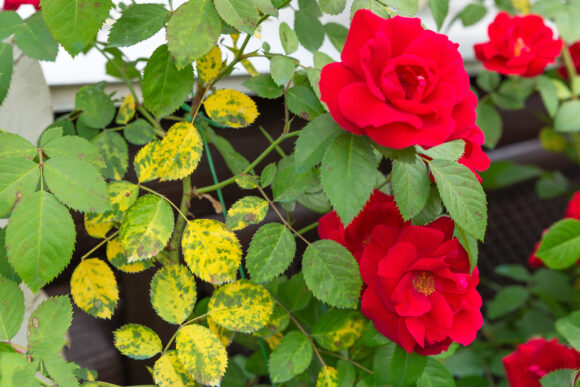
Black Spot Fungus on roses.
When it comes to preparing your garden for a successful season, one dogma should constantly be kept in mind—the Disease Triangle, or the three factors for disease to develop: 1) a susceptible host, 2) the pathogen, and 3) an environment favorable for the pathogen. Here are ways you can best prepare your garden for a productive season, while minding environmental, host plant, and plant pathogen factors at the onset and throughout the season.
Removing the pathogen, i.e., sanitation, is your secret weapon. Key areas of the garden and your methods should be the focus of reducing early season plant disease. The tools, propagation equipment, re-used containers, etc. used throughout the season should be scrubbed with soap and water (‘cleaned’) and then chemically ‘sanitized.’
Sanitation principles also apply to the garden itself, where leaf litter, diseased or dead plants and annuals, or dying branches of perennials should be removed. Physically removing potential plant pathogen inoculum from the garden adds an additional level of security to pathogen avoidance approaches. That said, many gardeners add some type of mulch or leaflitter to the garden to suppress weed growth, insulate against temperature extremes, and add nutrients or beauty to the landscape. How we handle this falls into one of two categories: 1) is the leaf litter from the garden itself or 2) is the leaf litter or mulch from another source? If the leaf litter present is from the garden plants and the garden is prone to foliar diseases, it should be removed, as this is the exact location many foliage-attacking pathogens overwinter. If the materials are from another location, they may not contain pathogens capable of attacking your garden plants. However, in either case if this material is to be removed it MUST be done so during dry conditions. For example, if a leaf blower is used and the litter and plants are wet, plant pathogens can be blown throughout the garden while having enough moisture (within the water droplets) to successfully infect new plants.
Speaking of moisture (environmental factors), how you water has a significant impact on the likelihood of various types of plant pathogens. Typically, anything you can do to keep foliage dry will greatly decrease the likelihood of foliar diseases, as many foliar pathogens require water to infect. Irrigation techniques such as drip or soaker hoses not only keep foliage dry, they also reduce overall watering needs and limit weed pressure. Conversely, overirrigation by any means often results in root-rot issues that ironically express as drought-stricken plants. If you know irrigation has been adequate but the plants seem to be continually wilted, a root pathogen is likely present, and these plants should be removed or treated.
Over-crowding (host factors) can also have massive impacts on disease severity. Individual diseases typically only attack a small group of host plants (excluding pathogens like Botrytis cinerea, a.k.a. grey mold), however the environmental factors that lead to plant disease are often very similar. If one plant is good, then three must be better, right? Not necessarily. In a crowded garden, reduced air flow promotes higher humidity and more favorable disease conditions. New plants should be placed at the correct spacing distances (ideally where mature plants will not touch) or pruned to promote less dense perennial canopies. In addition to increased airflow, these canopies also allow for better delivery of fertilizers or other materials.
Crowded plants competing for resources are less vigorous, thus more susceptible to disease, and you are less likely to notice until it is too late! Resist the temptation to over plant and you will thank yourself later. All this said, with less dense canopies more sunlight will reach the soil until canopy closure, therefore weeds can be problematic early in the season. We all know weeds are a common problem in the garden, however, did you know that they can act as pathogen overwintering locations or harbor diseases that can attack similar plants in your garden? Their removal also aids in promoting airflow and removes their competition for resources, thus promoting more vigorous plants.
When preparing for a successful season, starting and staying clean (tools, propagation areas, and leaf litter), promoting increased airflow, reducing overhead irrigation, and maintaining healthy plants in various ways, all play into utilizing the Disease Triangle to avoid plant disease at the beginning and throughout the season.
If you have issues with disease, contact the Rutgers Plant Diagnostic Laboratory to have them evaluated (fee based). Additional resources can be obtained through the Rutgers Master Gardeners website including ‘Call a Rutgers Master Gardener,’ ‘Lawn & Garden Frequently Asked Questions,’ or becoming a Rutgers Master Gardener. Rutgers factsheets on lawn and garden and other topics also provides useful information.
Editor’s note: This originally appeared in Gardener News and was written by Timothy Waller, agricultural agent for Rutgers Cooperative Extension of Cumberland County.

